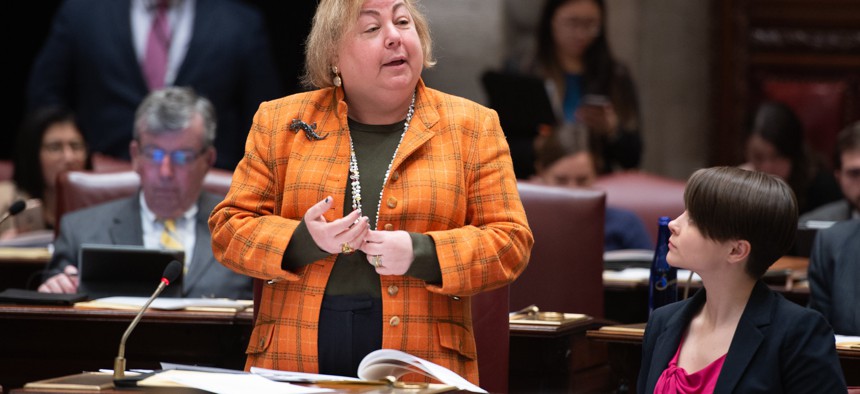Editor’s note: Since this story was printed in our magazine, Gov. Andrew Cuomo has updated his marijuana legalization proposal. Amendments include more specifics on how proposed funding for social equity will be spent and a change permitting delivery services for legal marijuana. The governor also announced changes to proposed penalties for the sale of marijuana to underage people and the sale of illicit marijuana, making punishments for both crimes less severe. This post has been updated accordingly. Read more here.
For the third year in a row, Gov. Andrew Cuomo and state legislators have dueling proposals to legalize recreational marijuana. State Sen. Liz Krueger and Assembly Majority Leader Crystal Peoples-Stokes have already introduced the latest version of their Marijuana Regulation and Taxation Act. Cuomo has once again made his pitch, dubbed the Cannabis Revenue and Taxation Act, as part of his executive budget, which has not yet been formally introduced to the Legislature. The two approaches have similarities, including the general oversight structure, but still differ in a few areas, including taxes. Here’s the breakdown:
| Peoples-Stokes and Krueger’s proposal | Cuomo’s proposal | |
|---|---|---|
| Oversight structure | Marijuana programs are overseen by the Office of Cannabis Management, which includes a Cannabis Control Board, an advisory board and an executive director, nominated by the governor and confirmed by the Legislature. | Marijuana programs are overseen by the Office of Cannabis Management, which includes a Cannabis Control Board and an executive director, appointed by the governor. |
| Tax structure | Imposes an 18% excise tax, which can go as high as 22% with additional optional local taxes municipalities may impose. | Imposes a 10.25% sales tax, in addition to any local sales tax that may apply, as well as an excise tax based on the potency and type, ranging from .7 cents per milligram to 4 cents per milligram. |
| Home cultivation | Anyone can grow, cultivate and process up to six marijuana plants at one time in their private residence. | No one can grow, cultivate or process any amount of marijuana in their private residence. |
| Tax revenue | The bulk of tax revenue would be split three ways: 50% to a community grants reinvestment fund, 25% to a drug treatment and public education fund and 25% to the state lottery fund to go towards the state Department of Education. | Tax revenue would in part go into a cannabis social equity fund on a schedule of $10 million in fiscal year 2023, $20 million in fiscal year 2024, $30 million in fiscal year 2025, $40 million in fiscal year 2026 and $50 million every year after. Use of the rest of the funds would largely be left to the discretion of the state. |
| Licenses available | Legislation provides for cultivator, processor, distributor, retail, cooperative, microbusiness, nursery, on-site consumption and delivery licenses. No person or company can hold a retail license if they hold a cultivator, processor or distributor license. The exception is a microbusiness license, which allows small-enough operations to retail what they grow. | Legislation provides for cultivator, processor, distributor, retail and cooperative licenses. Delivery services will also be permitted. Microbusiness licenses – which permit businesses to cultivate, process, distribute and retail their own cannabis if they are small enough – are mentioned as an option, but not explicitly required. No person or company with a retail license can hold a cultivator, processor or distributor license. |
| Social equity plan | Includes provisions for the creation of a social equity plan that would prioritize licensing of and provide assistance to minority- and women-owned businesses, disadvantaged farmers and people from communities harmed by marijuana enforcement in the past, including those with past convictions. Mandates the creation of an incubator program and sets a goal that 50% of licenses will go to social equity applicants. | Includes provisions for the creation of a social equity plan that would prioritize licensing of and provide assistance to minority- and women-owned businesses, disadvantaged farmers and people from communities harmed by marijuana enforcement in the past, including those with past convictions. |
| Social equity oversight | Has a chief equity officer tasked with helping to create and ensure continued compliance with the social equity plan, as well as establishing a public education plan for communities that have experienced negative consequences from past pot enforcement. They would be required to produce yearly compliance reports and would chair a committee that administers community grant funds. | Has a deputy director for social and economic equity tasked with overseeing the social and economic equity plan, but with no specific statutory duties. |
| Past convictions | Includes a provision for the automatic expungement, vacature or sealing of low-level pot convictions that would not be crimes under the new law. | Permits those convicted of and currently serving time for low-level pot offenses that would no longer be crimes under the new law to seek a retrial or resentence. |
| Future enforcement | Makes sale of marijuana to someone under the age of 21 a Class A misdemeanor, and the sale of more than three ounces of marijuana to someone under the age of 18 a Class E felony. | Makes the sale of to someone under the age of 21 a Class A misdemeanor. |
| Legal possession | A person over 21 can legally carry up to three ounces of marijuana, or 24 grams of concentrated cannabis (like in edibles). | A person over 21 can legally carry up to one ounce of marijuana, or five grams of concentrated cannabis (like in edibles). |


